Introduction to Millimeter Wave Technology for E-Band
E-Band MMW Summary
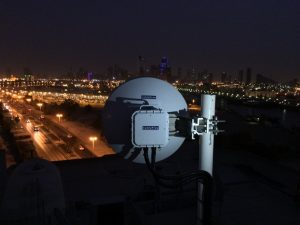
Millimeter Wave (MMW) using E-Band and V-Band is a technology for high speed (10Gbps, 10 Gigabit per second) high capacity wireless links, ideal for urban areas. Using high frequency microwave in the E-Band (70-80GHz) and 58GHZ to 60GHz (V-Band) spectrum, links can be densely deployed in congested cities without interference, and without need for digging for cables and fibre optics, which can be costly, slow and highly disruptive. By contrast, MMW links can be deployed in hours, and moved and reused on different sites as network requirements evolve.
History of MMW
In 2003 the North American Federal Communications Commission (FCC) opened several high frequency millimeter-wave (MMW) bands, namely in the 70, 80, and 90 gigahertz (GHz) ranges, for commercial and public use. Due to the vast amount of spectrum (roughly 13 GHz) available in these bands, millimeter-wave radios have quickly become the fastest point-to-point (pt-to-pt) radio solution on the market. Radio transmission products offering full-duplex data rates up to 1.25 Gbps, at carrier class availability levels of 99.999%, and over distances close to one mile or more are available today. Due to cost-effective pricing, MMW radios have the potential to transform business models for mobile backhaul providers and metro/enterprise “Last-Mile” access connectivity.
Regulatory Background
The opening of 13 GHz of previously unused spectrum in the 71…76 GHz, 81…86 GHz and 92…95 GHz frequency ranges, for commercial use, and high-density fixed wireless services in the United States in October 2003 is regarded as a landmark ruling by the Federal Communications Commission (FCC). From a technological point of view this ruling allowed for the first time, full line speed and full-duplex gigabit-speed wireless communications over distances of one mile or more at carrier-class availability levels. At the time of opening the spectrum for commercial use, FCC Chairman Michael Powell heralded the ruling as opening a “new frontier” in commercial services and products for the American people. Since then, new markets for fibre replacement or extension, point-to-point wireless “Last-Mile” access networks, and broadband Internet access at gigabit data rates and beyond have been opened.
The significance of the 70 GHz, 80 GHz and 90 GHz allocations cannot be overstated. These three allocations, collectively referred to as E-band, comprise the largest amount of spectrum ever released by the FCC for licensed commercial use. Together, the 13 GHz of spectrum increases the amount of FCC-approved frequency bands by 20% and these bands combined represent 50 times the bandwidth of the entire cellular spectrum. With a total of 5 GHz of bandwidth available at 70 GHz and 80 GHz, respectively, and 3 GHz at 90 GHz, gigabit Ethernet and higher data rates can easily be accommodated with relatively simple radio architectures and without complex modulation schemes. With propagation characteristics being only slightly worse than those at the widely used microwave bands, and well-characterized weather characteristics allowing rain fade to be understood, link distances of several miles can confidently be realized.
The FCC ruling also laid the foundation for a novel Internet based licensing scheme. This online licensing scheme allows fast registration of a radio link and provides frequency protection at a low one time charge of a few hundred dollars. Many other countries around the globe are currently opening the MMW spectrum for public and commercial use , following the landmark ruling of the FCC. Within this paper we will try to explain the significance of the 70 GHz, 80 GHz and 90 GHz bands, and show how these new frequency allocations will potentially reshape high data rate transmission and associated business models.
Target Markets and Applications for High Capacity “Last-Mile” Access Connectivity
In the United States alone, there are roughly 750,000 commercial buildings with 20+ employees. In today’s highly Internet connected business environments the majority of these buildings need high data rate Internet connectivity. While it is certainly true that many businesses are currently satisfied with having a slower speed T1/E1 at 1.54 Mbps or 2.048 Mbps, respectively, or any other form of slower speed DSL connection, a rapidly growing number of businesses are requiring or demanding DS-3 (45 Mbps) connectivity or higher speed fibre connections. However, and here is where the problems starts, according to a very recent study by Vertical Systems Group, only 13.4% of the commercial buildings in the United Sates are connected to a fibre network. In other words, 86.6% of these building have no fibre connection, and building tenants rely on leasing slower speed wired copper circuits from the incumbent or alternative telephony providers (ILECs or CLECs). Such costs for a higher speed wired copper connection like a 45 Mbps DS-3 connection, can easily run to $3,000 a month or more.
Another interesting study conducted by Cisco in 2003 revealed that 75% of the U.S. commercial buildings that are not connected to fibre are within one mile of a fibre connection. However, despite the growing demand for high capacity transmission into these buildings, the cost associated with laying fibre does very often not allow for “closing the transmission bottleneck”. For example, the costs of laying fibre in major U.S. metropolitan cities can run up to $250,000 per mile, and in many of the largest U.S. cities there is even a moratorium on laying new fibre because of the associated massive traffic disruptions. Fibre to commercial building connectivity figures in many European Cities are far worse and some studies suggest that only about 1% of commercial buildings are connected to fibre.
Many industry analysts agree that there is a large and presently underserved market for short-haul wireless “Last Mile” access connectivity provided that the underlying technology allows for carrier-class availability levels. MMW radio systems are perfectly suited to fulfill these technical requirements. Additionally, high capacity and commercially available MMW systems have drastically come down in pricing over the last couple of years. When compared to laying just one mile of fibre in a major metropolitan U.S. or European city, the use of a gigabit Ethernet capable MMW radio can run as low as 10% of the fibre costs. This pricing structure makes the economics of gigabit connectivity attractive because the required capital layout and the resulting Return on Investment (ROI) period are drastically shortened. Consequently, many high data rate applications that could not be served economically in the past due to the high infrastructure costs of trenching fibre can now be served and are economically feasible when using MMW radio technology. Among these applications are:
- CLEC and ILEC fibre extensions and replacements
- Metro Ethernet backhaul and fibre ring closures
- Wireless campus LAN extensions
- Fibre backup and path diversity in campus networks
- Disaster Recovery
- High capacity SAN connectivity
- Redundancy, portability and security for Homeland Security and Military
- 3G cellular and/or WIFI/WiMAX backhaul in dense urban networks
- Portable and temporary links for high-definition video or HDTV transport
Why use E-Band MMW Technology?
Of the three frequency bands opened up, the 70 GHz and 80 GHz bands have attracted most interested by equipment manufacturers. Designed to co-exist, the 71…76 GHz and 81…86 GHz allocations allow 5 GHz of full-duplex transmission bandwidth; enough to easily transmit a full-duplex gigabit Ethernet (GbE) signal even with the simplest modulation schemes. The advanced Wireless Excellence design even managed to use the lower 5 GHz band, from 71…76 GHz only, to transport a full duplex GbE signal. Later, a clear advantage is shown in using this approach when it comes to the deployment of MMW technology close to astronomical sites and in countries outside of the U.S. With direct data conversion (OOK) and low-cost diplexers, relatively simple and thus cost efficient and high reliable radio architectures can be achieved. With more spectrally efficient modulation codes, even higher full-duplex transmission at 10 Gbps (10GigE) up to 40Gbps can be reached.
The 92…95 GHz allocation is far more difficult to work with because this part of the spectrum is segmented into two unequal portions that are separated by a narrow 100 MHz exclusion band between 94.0…94.1 GHz. It can be assumed that this part of the spectrum will more likely be used for higher capacity and shorter range indoor applications. This allocation will not be discussed further in this white paper.
Under clear weather conditions, the transmission distances at 70 GHz and 80 GHz exceed many miles due to low atmospheric attenuation values. However, Figure 1 shows that even under these conditions the atmospheric attenuation varies significantly with frequency [1]. At conventional, lower microwave frequencies and up to roughly 38 GHz, atmospheric attenuation is reasonably low with attenuation values of a few tenths of a decibel per kilometre (dB/km). At around 60 GHz absorption by oxygen molecules causes a large spike in attenuation. This large increase of oxygen absorption seriously limits radio transmission distances of 60 GHz radio products. However, beyond the 60 GHz oxygen absorption peak a wider low attenuation window opens up where attenuation drops back to values around 0.5 dB/km. This window of low attenuation is commonly referred to as E-band. The E-band attenuation values are close to the attenuation experienced by common microwave radios. Above 100 GHz, atmospheric attenuation generally increases and in addition there are numerous molecular absorption bands caused by O2 and H2O absorption at higher frequencies. In summary, it is the relatively low atmospheric attenuation window between 70 GHz and 100 GHz that makes E-band frequencies attractive for high capacity wireless transmission. Figure 1 also shows how rain and fog impact attenuation in microwave, millimeter-wave and infrared optical bands that start around 200 terahertz (THz) and that are used in FSO transmission systems. At various and specific rainfall rates attenuation values change slightly, with increasing transmission frequencies. The relationship between rainfall rates and transmission distances will be examined further in the following section. Fog related attenuation can basically be neglected at millimeter-wave frequencies, increasing by several orders of magnitude between the millimeter-wave and the optical transmission band: The main reason why longer distance FSO systems stop working under foggy conditions.
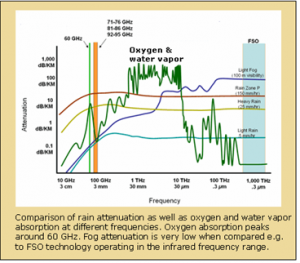
Transmission Distances for E-Band
As with all high-frequency radio propagation, rain attenuation typically determines the practical limits on transmission distances. Figure 2 shows that radio systems operating in the E-band frequency range can experience large attenuation given the presence of rain [2]. Fortunately, the most intense rain tends to fall in limited parts of the world; mainly the subtropical and equatorial countries. At peak times rainfall rates of more than seven inches/hour (180 mm/hour) can be observed for short periods of time. In the United States and Europe, maximum rainfall rates experienced are typically less than four inches/hour (100 mm/hr). Such a rainfall rate causes signal attenuations of 30 dB/km, and generally occurs only during short cloud bursts. These cloud bursts are rain events that appear within relatively small and localized areas and within a lower intensity, larger diameter rain cloud. Since cloud bursts are also typically associated with severe weather events that move quickly across the link, rain outages tend to be short and are only problematic on longer distance transmission links.
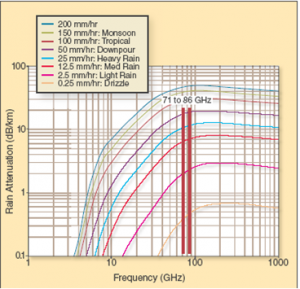
The International Telecommunications Union (ITU) and other research organizations have collected decades of rainfall data from all over the world. In general, rainfall characteristics and relationships between rainfall rate, statistical rain duration, rain drop sizes, etc. are well-understood [3] and by using this information it is possible to engineer radio links to overcome even the worst weather events or to predict the durations of weather related outages on longer distance radio links operating at specific frequencies. The ITU rain zone classification scheme shows the expected statistical rainfall rates in alphabetical order. While areas that experience the least rainfall are classified as “Region A,” the highest rainfall rates are in “Region Q.” A global ITU rain zone map and a listing of the rainfall rates in specific regions of the world is shown in Figure 3 below.
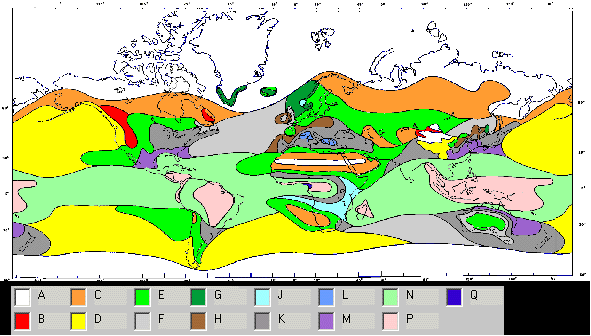
Figure 3: ITU rain zone classification of different regions around the world (top) and actual statistical rainfall rates as a function of the rain event duration
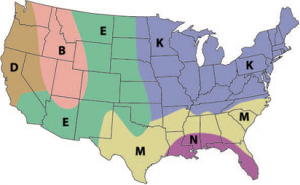
Figure 4 shows a more detailed map for North America and Australia. It is worthwhile to mention that roughly 80% of the Continental US territory falls into rain zone K and below. In other words, to operate at a 99.99% availability level, a radio system’s fade margin must be designed to withstand a maximum rainfall rate of 42 mm/hour. The highest rainfall rates in North America can be observed in Florida and along the Gulf Coast, and these regions are classified under rain zone N. In general, Australia experiences less rain than North America. Huge parts of this country including the more populated Southern coast line are located in rain zones E and F (<28 mm/h).
To simplify, by combining the results of Figure 2 (rainfall rate vs. attenuation) and using the ITU rainfall charts shown in Figures 3 and 4, it is possible to calculate the availability of a particular radio system operating in a certain part of the world. Theoretical calculations based on rainfall data for the United States, Europe and Australia show that 70/80 GHz radio transmission equipment can achieve GbE connectivity at a statistical availability level of 99.99…99.999% over distances close to one mile or even beyond. For a lower 99.9% availability, distances exceeding 2 miles can be routinely achieved. When configuring the network in a ring or mesh topology, effective distances double in some cases for the same availability figure due to the dense, clustering nature of heavy rain cells and the path redundancy that ring/mesh topologies provide.
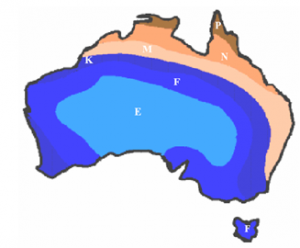
Figure 4: ITU rain zone classification for North America and Australia
One strong benefit of MMW technology over other high capacity wireless solutions like free space optics (FSO) is that MMW frequencies are unaffected by other transmission impairments such as fog or sandstorms. Thick fog, for example, with a liquid water content of 0.1 g/m3 (about 50 m visibility) has just 0.4 dB/km attenuation at 70/80 GHz [4]. Under these conditions, an FSO system will experience a signal attenuation of more than 250 dB/km [5]. These extreme attenuation values show why FSO technology can only provide high availability figures over shorter distances. E-band radio systems are similarly unaffected by dust, sand, snow and other transmission path impairments.
Alternative High Data Rate Wireless Technologies
As alternatives to E-band wireless technology, there are a limited number of viable technologies capable of supporting high data rate connectivity. This section of the white paper provides a short overview.
Fibre-Optic Cable
Fibre-optic cable offers the widest bandwidth of any practical transmission technology, allowing very high data rates to be transmitted over long distances. Although thousands of miles of fibre are available worldwide and in particular in long haul and inter-city networks, “Last-Mile” access remains limited. Due to substantial and often prohibitively high up-front costs associated with digging trenches and laying terrestrial fibre, as well as right-of way issues, fibre access can be difficult to impossible. Long delays are also frequent, not only because of the physical process of trenching fibre, but also due to obstacles caused by environmental impacts and potential bureaucratic hurdles involved in such a project. For this reason, many cities around the world are prohibiting fibre trenching because of disruption to the inner-city traffic and the general inconvenience the trenching process causes to the public.
Microwave Radio Solutions
Fixed point-to-point microwave radios can support higher data rates such as full-duplex 100 Mbps Fast Ethernet or up to 500 Mbps per carrier in frequency ranges between 4-42 GHz. However, in the more traditional microwave bands the spectrum is limited, often congested and typical licensed spectrum channels are very narrow when compared to the E-Band spectrum.
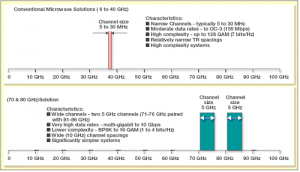
Figure 5: Comparison between high data rate microwave radios and a 70/80 GHz radio solution.
In general, the frequency channels available for licensing are often no more than 56 megahertz (MHz), but typically 30 MHz or below. In some bands, wide 112MHz channels capable of supporting 880Mbps per carrier may be available, but only in higher frequency bands suited for short distances. Consequently, radios operating in these bands at higher data rates have to employ highly complex system architectures employing modulation schemes up to 1024 Quadrature Amplitude Modulation (QAM). Such highly complex systems result in restricted distances, and throughput is still limited to data rates to 880Mbps in the largest channels. Due to the limited amount of spectrum available in these bands, the wider antenna beamwidth patterns, and the sensitivity of high QAM modulation towards any kind of interference, denser deployment of traditional microwave solutions in urban or metropolitan areas is extremely problematic. A visual spectrum comparison between the traditional microwave bands and the 70/80 GHz approach is shown in Figure 5.
60 GHz (V-Band) Millimeter Wave Radio Solutions
Frequency allocations within the 60 GHz spectrum, and in particular allocations between 57…66 GHz, vary significantly in different regions of the world. The North American FCC has released a wider block of frequency spectrum between 57…64 GHz that provides sufficient bandwidth for full-duplex GbE operation. Other countries have not followed this particular ruling and these countries only have access to much smaller and often channelized frequency allocations within the 60 GHz spectrum band. The limited amount of available spectrum outside of the U.S. does not allow for building cost effective 60 GHz radio solutions at high data rates in European, countries such as Germany, France and England just to mention a few. However, even in the U.S., the regulated limitation in transmission power, coupled with the relatively poor propagation characteristics due to high atmospheric absorption by oxygen molecules (see Figure 1), limits typical link distances to less than half a mile. To achieve carrier-class performance of 99.99…99.999% system availability, for large parts of the continental U.S. territory, the distance is generally limited to a little more than 500 yards (500 meters). FCC has categorized the 60 GHz spectrum as a license-free spectrum. Unlike the higher frequency 70/80 GHz allocations, operation of 60 GHz radio systems does not require legal approval or coordination. On one hand the use of unlicensed technology is very popular among end-users, but at the same time there is no protection against interference, either accidental or intentional. In summary, especially in the U.S., the use of the 60 GHz spectrum can be a potentially viable alternative for short distance deployments, but the technology is no real alternative for link distances beyond 500 meters and when 99.99…99.999% system availability is required.
Free Space Optics (FSO, Optical Wireless)
Free space optic (FSO) technology uses infrared laser technology to transmit information between remote locations. The technology allows transmitting very high data rates of 1. 5 Gbps and beyond. FSO technology is generally a very secure transmission technology, is not very prone to interference due to the extremely narrow transmission beam characteristics, and is also worldwide license-free.
Unfortunately, the transmission of signals in the infrared optical bands is drastically affected by fog, where atmospheric absorption can exceed 130 dB/km [5]. In general, any kind of weather condition that impacts the visibility between two locations (e.g. sand, dust), will also impact the FSO system performance. Fog events and dust/sand storms can also be very localized and difficult to predict, and consequently, the prediction of FSO system availability is more difficult. Unlike extreme rain events, that are very short in duration, fog and dust/sandstorms can also last very long times (hours or even days rather than minutes). This can result in extremely long outages for FSO systems operating under such conditions.
From a practical point of view, and when considering availability numbers of 99.99…99.999%, all of the above can limit FSO technology to distances of only a few hundred yards (300 meters); especially in coastal or fog-prone areas, as well as in regions that experience sand/dust storms. To maintain 100% connectivity when deploying FSO systems in these kinds of environments, an alternative path technology is recommended.
The majority of industry experts agree that FSO technology can offer an interesting and potentially inexpensive alternative in wirelessly connecting remote locations over shorter distances. However, the physics of signal attenuation in the infrared spectrum will always restrict this technology to very short distances.
A short comparison of the discussed and commercially available high data rate transmission technologies and their key performance drivers is shown in Table 1.
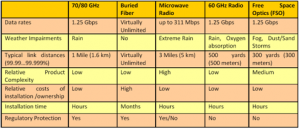
Table 1: Comparison chart of commercially available high data rate wireline and wireless transmission technologies
Commercially Available Millimeter-Wave Solutions
The CableFree Millimeter-wave product portfolio includes point-to-point radio solutions operating from 100 Mbps to 10 Gbps (10 Gigabit Ethernet) speeds in the licensed 70 GHz E-band spectrum and up to 1Gbps in the unlicensed 60 GHz spectrum. The systems are available with different antenna sizes to meet the customer’s availability requirements over specific deployment distances at the most competitive price points of any E-band radio manufacturer in the industry. Wireless Excellence’s E-band radio solutions operate in the lower 5 GHz frequency band of the licensed 70/80 GHz E-band spectrum only, rather than simultaneous transmission in both the 70 GHz and the 80 GHz bands. As a result, Wireless Excellence products are not prone to potential deployment restrictions close to astronomical sites or military installations in Europe, where the military is using parts of the 80 GHz band for military communications. The systems are easy to deploy, and due to the low voltage power feed of 48 volts direct current (Vdc), no certified electrician is required for installing the system. Photographs of the Wireless Excellence products are shown in Figure 6 below.
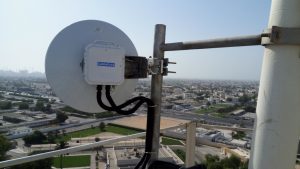
Figure 6: CableFree MMW radios are compact and highly integrated. 60cm antenna version shown
Summary and Conclusions
To solve today’s high capacity network interconnectivity requirements, highly reliable wireless solutions are available providing fibre-like performance at a fraction of the cost of laying fibre or leasing high capacity fibre connections. This is important not only from the performance/cost point of view, but also because fibre connections in “Last-Mile” access networks are still not very widespread and latest studies reveal that in the United States only 13.4% of commercial buildings with more than 20 employees are connected to fibre. These numbers are even lower in many other countries.
There are several technologies in the market that can provide gigabit connectivity to connect remote networking locations. Licensed E-band solutions in the 70/80 GHz frequency range are of particular interest because they can provide the highest carrier-class availability figures at operating distances of one mile (1.6 km) and beyond. In the United States a 2003 landmark FCC ruling has opened this spectrum for commercial use and an Internet based low cost light licensing scheme allows users to get a license for operation within a few hours. Other countries either already have and/or are currently in the process of opening the E-band spectrum for commercial use. Unlicensed 60 GHz radios and free-space optics (FSO) systems can also provide gigabit Ethernet connectivity, but at higher 99.99…99.999% carrier-class availability levels, both of these solutions are only capable of operating at reduced distances. As a simple rule of thumb and for most parts of the United States, 60 GHz solutions can provide these high availability levels only when being deployed at distances below 500 yards (500meters).
References
- ITU-R P.676-6, “Attenuation by Atmospheric Gases,” 2005.
- ITU-R P.838-3, “Specific Attenuation Model for Rain for Use in Prediction Methods,” 2005.
- ITU-R P.837-4, “Characteristics of Precipitation for Propagation Modeling,” 2003.
- ITU-R P.840-3, “Attenuation Due to Clouds and Fog,” 1999.
For More Information on E-Band Millimeter Wave
For further information on E-Band MMW and the range of CableFree wireless networking products:
Please Contact Us

You must be logged in to post a comment.